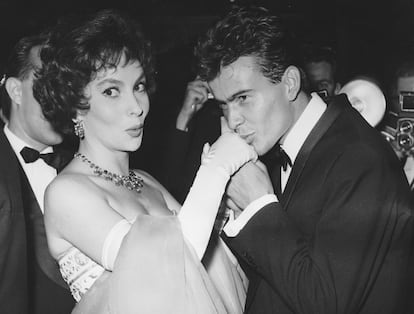Italian film legend Gina Lollobrigida dies at age 95
The actor began making movies in Italy just after the end of World War II, as the country began to promote on the big screen a stereotypical concept of Mediterranean beauty as buxom and brunette

Italian film legend Gina Lollobrigida, who achieved international stardom during the 1950s and was dubbed “the most beautiful woman in the world” after the title of one of her movies, died in Rome on Monday, her agent said. She was 95. The agent, Paola Comin, didn’t provide details. Lollobrigida had surgery in September to repair a thigh bone broken in a fall. She returned home and said she had quickly resumed walking.
A drawn portrait of the diva graced a 1954 cover of Time magazine, which likened her to a “goddess” in an article about Italian movie-making. More than a half-century later, Lollobrigida still turned heads with her brown, curly hair and statuesque figure, and preferred to be called an actress instead of the gender-neutral term actor.
“Lollo,” as she was lovingly nicknamed by Italians, began making movies in Italy just after the end of World War II, as the country began to promote on the big screen a stereotypical concept of Mediterranean beauty as buxom and brunette.
Besides “The World’s Most Beautiful Woman” in 1955, career highlights included Golden Globe-winner “Come September,” with Rock Hudson; “Trapeze;” “Beat the Devil,” a 1953 John Huston film starring Humphrey Bogart and Jennifer Jones; and “Buona Sera, Mrs. Campbell,” which won Lollobrigida Italy’s top movie award, a David di Donatello, as best actress in 1969.
In Italy, she worked with some of the country’s top directors following the war, including Mario Monicelli, Luigi Comencini, Pietro Germi and Vittorio De Sica.
Two of her more popular films at home were Comencini’s “Pane Amore e Fantasia” (“Bread, Love and Dreams”) in 1953, and the sequel a year later, “Pane Amore e Gelosia” (“Bread, Love and Jealousy”). Her male foil was Vittorio Gassman, one of Italy’s leading men on the screen.
Lollobrigida also was an accomplished sculptor, painter and photographer, and eventually essentially dropped film for the other arts. With her camera, she roamed the world from what was then the Soviet Union to Australia. In 1974, Fidel Castro hosted her as a guest in Cuba for 12 days as she worked on a photo reportage.
Lollobrigida was born on July 4, 1927 in Subiaco, a picturesque hill town near Rome, where her father was a furniture maker. Lollobrigida began her career in beauty contests, posing for the covers of magazines and making brief appearances in minor films. Producer Mario Costa plucked her from the streets of Rome to appear on the big screen.
Eccentric mogul Howard Hughes eventually brought Lollobrigida to the United States, where she performed with some of Hollywood’s leading men of the 1950s and 60s, including Frank Sinatra, Sean Connery, Burt Lancaster, Tony Curtis and Yul Brynner.
Over the years, her co-stars also included Europe’s most dashing male stars of the era, among them Louis Jourdan, Fernando Rey, Jean-Paul Belmondo, Jean-Louis Trintignant and Alec Guinness.
While Lollobrigida played some dramatic roles, her sex symbol image defined her career, and her most popular characters were in lighthearted comedies such as the “Bread, Love” trilogy.
With lush eyelashes and thick, brown curls framing her face, Lollobrigida started a hairstyle rage in the 1950s known as the “poodle cut.” Gossip columnists commented on alleged rivalries between her and Sophia Loren, another Italian film star celebrated for her beauty,
In middle age, Lollobrigida’s romance with a man 34 years her junior, Javier Rigau, from Barcelona, Spain, kept gossip pages buzzing for years.
“I have always had a weakness for younger men because they are generous and have no complexes,” the actress told Spain’s “Hola” magazine. After more than 20 years of dating, in 2006, the then-79-year-old Lollobrigida announced that she would marry Rigau, but the wedding never happened.
Her first marriage, to Milko Skofic, a Yugoslavia-born doctor, ended in divorce in 1971.
In the last years of her life, Lollobrigida’s name more frequently appeared in articles by journalists covering Rome’s courts, not the glamour scene, as legal battles were waged over whether she had the mental competence to tend to her finances.
On her website, Lollobrigida recalled how her family lost its house during the bombings of World War II and went to live in Rome. She studied sculpture and painting at a high school dedicated to the arts, while her two sisters worked as movie theater ushers to allow her to continue her studies.
Tu suscripción se está usando en otro dispositivo
¿Quieres añadir otro usuario a tu suscripción?
Si continúas leyendo en este dispositivo, no se podrá leer en el otro.
FlechaTu suscripción se está usando en otro dispositivo y solo puedes acceder a EL PAÍS desde un dispositivo a la vez.
Si quieres compartir tu cuenta, cambia tu suscripción a la modalidad Premium, así podrás añadir otro usuario. Cada uno accederá con su propia cuenta de email, lo que os permitirá personalizar vuestra experiencia en EL PAÍS.
¿Tienes una suscripción de empresa? Accede aquí para contratar más cuentas.
En el caso de no saber quién está usando tu cuenta, te recomendamos cambiar tu contraseña aquí.
Si decides continuar compartiendo tu cuenta, este mensaje se mostrará en tu dispositivo y en el de la otra persona que está usando tu cuenta de forma indefinida, afectando a tu experiencia de lectura. Puedes consultar aquí los términos y condiciones de la suscripción digital.
More information
Archived In
Últimas noticias
Most viewed
- Alain Aspect, Nobel laureate in physics: ‘Einstein was so smart that he would have had to recognize quantum entanglement’
- Mexico’s missing people crisis casts a shadow over World Cup venue
- Why oil has been at the center of Venezuela-US conflicts for decades
- Trump clarifies who is ultimately in charge in Venezuela: ‘Me’
- Mexico seeks to shore up its defenses following US incursion in Venezuela










































